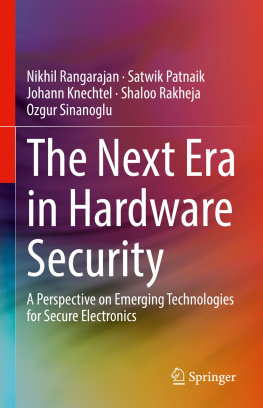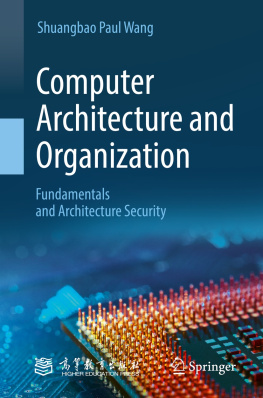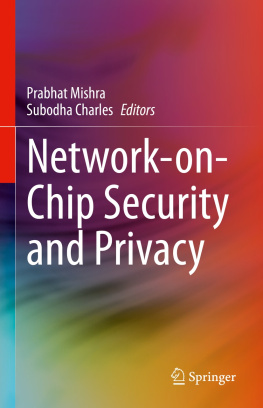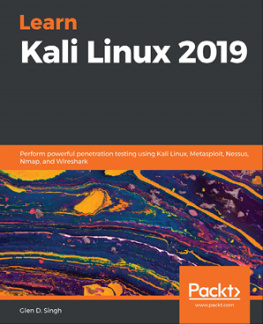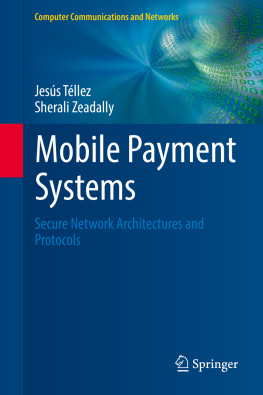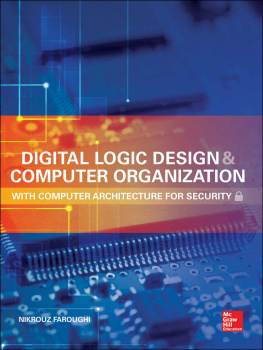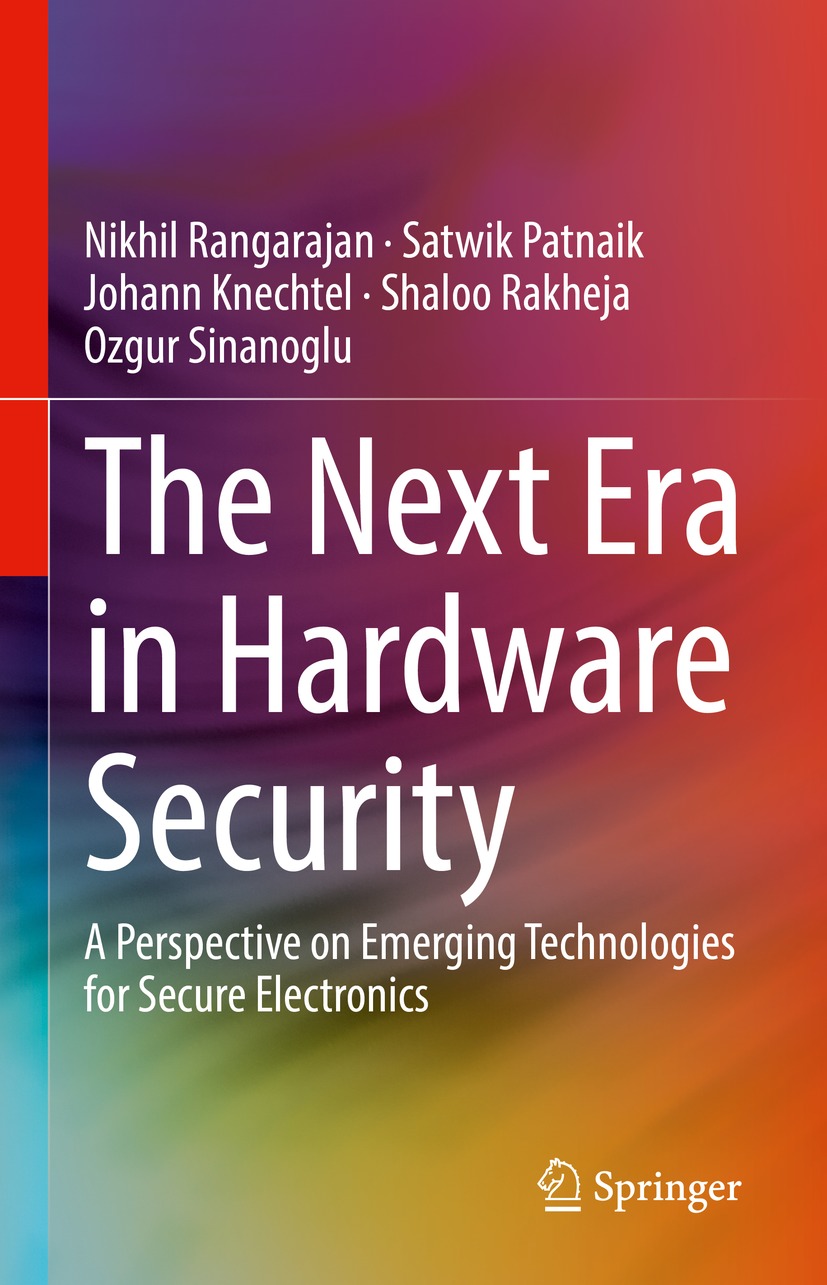Nikhil Rangarajan , Satwik Patnaik , Johann Knechtel , Shaloo Rakheja and Ozgur Sinanoglu
The Next Era in Hardware Security
A Perspective on Emerging Technologies for Secure Electronics
1st ed. 2021

Logo of the publisher
Nikhil Rangarajan
Division of Engineering, New York University Abu Dhabi, Abu Dhabi, United Arab Emirates
Satwik Patnaik
Department of Electrical and Computer Engineering, Texas A&M University, College Station, TX, USA
Johann Knechtel
Division of Engineering, New York University Abu Dhabi, Abu Dhabi, United Arab Emirates
Shaloo Rakheja
Holonyak Micro and Nanotechnology Laboratory, University of Illinois at Urbana Champaign, Urbana, IL, USA
Ozgur Sinanoglu
Division of Engineering, New York University Abu Dhabi, Abu Dhabi, United Arab Emirates
ISBN 978-3-030-85791-2 e-ISBN 978-3-030-85792-9
https://doi.org/10.1007/978-3-030-85792-9
The Editor(s) (if applicable) and The Author(s), under exclusive license to Springer Nature Switzerland AG 2021
This work is subject to copyright. All rights are solely and exclusively licensed by the Publisher, whether the whole or part of the material is concerned, specifically the rights of translation, reprinting, reuse of illustrations, recitation, broadcasting, reproduction on microfilms or in any other physical way, and transmission or information storage and retrieval, electronic adaptation, computer software, or by similar or dissimilar methodology now known or hereafter developed.
The use of general descriptive names, registered names, trademarks, service marks, etc. in this publication does not imply, even in the absence of a specific statement, that such names are exempt from the relevant protective laws and regulations and therefore free for general use.
The publisher, the authors and the editors are safe to assume that the advice and information in this book are believed to be true and accurate at the date of publication. Neither the publisher nor the authors or the editors give a warranty, expressed or implied, with respect to the material contained herein or for any errors or omissions that may have been made. The publisher remains neutral with regard to jurisdictional claims in published maps and institutional affiliations.
This Springer imprint is published by the registered company Springer Nature Switzerland AG
The registered company address is: Gewerbestrasse 11, 6330 Cham, Switzerland
We acknowledge all the efforts by the medical community, the research community, and everyone else affected by and dealing with the COVID-19 pandemic. We also extend our condolences to those who have lost loved ones.Nikhil, Satwik, Johann, Shaloo, and Ozgur
To Anja and Richard. I am truly grateful for having you both in my life. Richard, may you have a bright future; be curious, be courageous, and be humble on all your paths through life.Johann
To my wife and my parents, who have been my pillar of strength and whose constant support has helped me through times thick and thin.Nikhil
Foreword
With technology scaling reaching nanometer range and the ever-increasing demands for new application domains, emerging technologies, different from conventional CMOS VLSI, are seriously being investigated to complement it. Emerging technologies based on novel materials and new computing paradigms represent an alternate paradigm in the quest for secure and robust electronics. Conventional logic and memory systems have traditionally employed security as an afterthought, if at all, at the circuit or system design stage. However, emerging technologies and novel materials can offer a unique opportunity to incorporate security-centric design practices at the device conception stage itself. By promoting device-circuit co-design with security as a prime metric (along with the traditional power, performance, and area considerations), emerging technologies may indeed reinvent the way we think about hardware security.
This book provides well-curated insights for the potential of emerging devices, materials, and the resulting novel architectures to tackle various challenges of hardware security, ranging from intellectual property protection to data security. Each chapter describes a particular set of properties, which are promising to advance the state of the art for the implementation of security schemes. Broad and informative reviews of seminal emerging technologies and their related security schemes are included, along with detailed case studies to highlight the most important aspects of emerging secure electronics. This book aims to educate the reader on the various approaches and practices employed for forging emerging technologies into viable security schemes. The tutorial-style writing and organization aids the reader through the whole process, starting from (1) a pedagogical connecting the dots approach for mapping the needs and requirements of particular security primitives with the properties offered by emerging technologies, over to (2) reviews of relevant concepts, and (3) detailed case studies, which can inspire readers to apply their own knowledge of emerging technologies and security, to not only learn but possibly devise their own schemes.
Mehdi Tahoori

Karlsruhe, Germany
June 2021
Preface
This book describes recent research at the confluence of hardware security and emerging technologies and complements it thoroughly with fundamentals of both domains. This book focuses on the unique properties of emerging technologies pertinent to the needs of hardware security and discusses methodologies to leverage those properties in order to build secure computing and storage systems. It presents these security-centric device characteristics in a structured and logical manner, along with recent research results, which serve well for both educational purposes and to motivate further interest and research in this field.
More specifically, this book is a comprehensive compilation of hardware security concepts borne out of the unique characteristics of emerging logic and memory devices, and related architectures. The primary focus is on mapping emerging technology-specific properties like multi-functionality, runtime polymorphism, intrinsic entropy, nonlinearity, ease of heterogeneous integration, tamper-resilience, and side-channel resistance to the corresponding security primitives that they help realize, namely static and dynamic camouflaging, true random number generation, physical unclonable functions, secure heterogeneous and large-scale systems, tamper-proof hardware, and side-channel-resilient circuits, respectively. We discuss several technologies offering the desired properties, including but not limited to spintronics switches, memristors, silicon nanowire transistors, and optoelectronic devices, for such security primitives and schemes, while also providing detailed case studies for each of the outlined security application. Overall, the book aims to provide a holistic perspective of how the promising properties found in emerging technologies, which are not readily afforded by traditional CMOS devices and systems, can help advance the field of hardware security.

